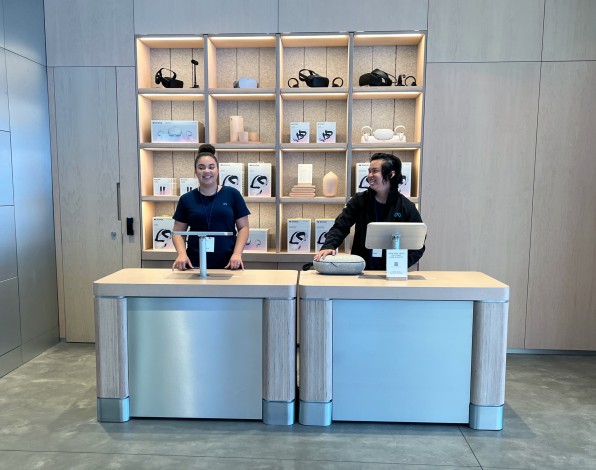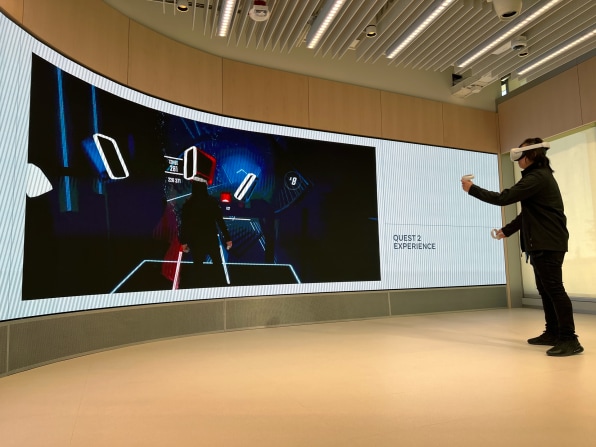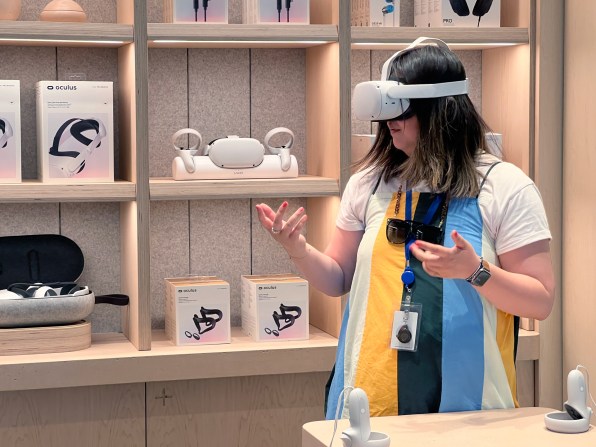- | 9:10 am
Meta’s first store takes on a basic problem with selling new tech
Tech companies have a lousy record with brick-and-mortar retail. But one way or another, Meta’s future rides on consumers’ ability to try its products.

Sooner or later, every tech giant decides to get into the retail business.
There’s Apple, of course, whose 500-plus stores rank among its greatest, most disruptive successes. But also Microsoft (twice). And Google, Amazon, Samsung, and Sony.
And now, Meta. On Monday, the company formerly known as Facebook is opening its first Meta Store, a retail outlet open to the public. It’s located in Burlingame, California, on the campus of the company’s 17,000-employee Reality Labs arm. That’s the group responsible for the Meta Quest 2 headset, Portal video-calling device, and Ray-Ban Stories camera-enabled sunglasses—the products the store will feature. You’ll be able to buy Quest and Portal devices there, though—weirdly—not the Ray-Ban Stories, which staffers will help interested shoppers purchase online. (Ray-Ban owner Luxottica oversees their retail distribution, apparently precluding Meta from selling them.)

[Photo: Harry McCracken]
Now, I probably don’t have to mention that Apple’s spectacular run in retail is not typical among technology companies, most of whom eventually lose interest in the whole idea. In just the last couple of years, the shutterings have included Microsoft’s 83-store chain, Sony’s last U.S. store, and dozens of Amazon shops. Which raises a question: Why do tech companies bother becoming brick-and-mortar merchants when it rarely goes anywhere?
Much of the time, moving product does not seem to be the primary goal; the companies in question are fine with your checking out the goods but then buying somewhere else. Instead, it’s about showing off goods with a level of TLC they rarely get at big-box retailers, where merchandising is more about filling shelves than telling a story. Back in 1999, for instance, Microsoft described MicrosoftSF, at San Francisco’s Metreon, as a “retail environment” rather than a computer store, and quoted Steve Ballmer explaining that it was “dedicated to showing, in an interactive environment, the way technology can enhance our working, learning, living, and playing.”
The fact that many tech-company retail presences aren’t about creating a new profit center might be why they eventually feel expendable. When MicrosoftSF closed, just two and a half years after it opened, Microsoft told CNET that the store—excuse me, the retail environment—”no longer fit the company’s core business priorities.” Eight years later, after the Apple Store became a phenomenon, retail once again was a priority for Microsoft—until it wasn’t. (The company did keep three locations around as Experience Centers, once again deemphasizing actual sales transactions.)

[Photo: Harry McCracken]
As for Meta, it isn’t saying anything about any long-term aspirations it might have for the Meta Store other than that operating the first one “will help define our retail strategy.” But when I made a preopening visit, nothing about the place felt like the beginnings of an Apple-like retail empire. For starters, it’s small: At 1,550 square feet, the space is roughly a fifth the size of my nearest Apple Store. When I dropped in, it didn’t take many Meta employees and members of the media to leave it feeling a tad claustrophobic; a throng of customers would overwhelm the joint.
Rather than getting space in a well-trafficked mall or shopping district, Meta is opening the store on its own premises, where it might be easier to keep tabs on, but intrigued passersby will be in short supply. Then there’s the fact that it’s open only Monday to Friday, 11 a.m. to 6 p.m.—not exactly prime time for gadget shopping.
My colleague Elizabeth Segran described Google’s new New York City store as feeling more like an interactive museum than a shopping destination: It’s full of quirky installations, such as a spot where you can say something and have it instantly translated into 24 languages via Google Translate. By contrast, Meta’s store is focused on the simple goal of giving you hands-on experience with the company’s devices: “At the Meta Store, we want you to interact with everything,” explains the company’s blog post on the opening. “We want you to pick stuff up. We want you to feel it.” The closest thing to spectacle is a Quest 2 tryout area where the headset display is replicated on a giant screen behind you, so bystanders can see what you see in such VR experiences as Beat Saber.

[Photo: Harry McCracken]
The emphasis on letting consumers pick up and feel stuff makes sense, especially for the Quest 2. More than any other consumer technology, VR is difficult to understand until you’ve experienced it yourself. Yet, it’s surprisingly tough for prospective owners to get hands-on time. The Best Buy store I shop at most often has a semi-prominent space dedicated to the Meta Quest 2—next to the Apple products, and across from the Lego aisle. But the sample headset is bolted to its stand, and there’s no evidence that you might be able to try it out. I had to go to BestBuy.com to learn that such demos are available from Meta staffers, though only at selected stores and only during certain weekend hours.
In general, mass-market retailers aren’t great places to learn about new products; it’s no shocker that Meta might want to take on more of the responsibility itself. But having to help consumers understand its products is still a relatively new experience for the company. Back when it was a startup called Facebook, it got huge fast because of its friction-free virality. People joined because their friends were there, and the whole process required barely any consideration. Later, WhatsApp and Instagram benefited from similar dynamics.

By trying to reinvent itself around the metaverse and building its own wildly ambitious hardware, Meta is creating a new challenge for itself. Its upcoming AR glasses may call for even more explaining and hands-on experience than a Quest headset. And while the Quest 2 starts at a reasonably affordable $299, the glasses could be much pricier; more people might want to see them for themselves before plunking down any money. If the fate of the company indeed rides on them taking off, you can understand why Meta might not want to depend on existing retailers figuring out how to sell them.So even if the new Meta Store is a relatively small whoop—and even if it doesn’t stick around forever—it’s trying to solve a real problem. And since the problem isn’t uniquely Meta’s, it’s a safe bet that it won’t be the last tech company to try its hand at playing shopkeeper.

































